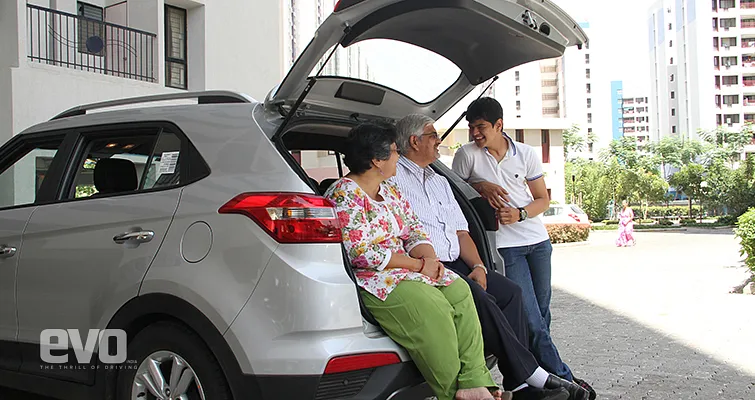Like father, like son: Hyundai Santa Fe & Creta

Words: Dipayan Dutta
Photography: Vikrant Date
How do you go about building a segment buster, a car that rules the roost in its segment without much else to challenge it? You don’t just enter a segment and declare yourself king. First things first, you have to understand your customer, and not just identify them, but be able to identify yourself with them. Understand what they need, when they might be likely to need it and be able to provide that in the best possible package, at the most reasonable price. Now saying all of this is actually a lot easier than sitting down and doing it. There’s only one thing that can make it perfect – despite the fact that clichés are for duds – practice and experience.

Take the Hyundai Creta for example. When it broke cover earlier this year, other than the barrage of urban dictionary jokes, one thing that everyone knew for sure was that it had everything it takes to be a winner in its segment. In all honesty over the years the compact SUV segment has turned quite drab. The Hyundai Creta then turned out to be a breath of fresh air. What shows through is the experience that Hyundai have garnered over the years in the SUV segment. It all began with the Terracan way back in 2003. Now even though both the Terracan and the Tucson were exceptional vehicles, they hadn’t timed their entry into the market quite right, which meant that Hyundai wasn’t as successful as they would have liked to be until 2008. Which is when they launched the Santa Fe.

Globally speaking, the Santa Fe replaced the then aging Tucson. Now considering the hardened competition in its segment, namely the Mitsubishi Pajero and the best selling Toyota Fortuner, most critics thought that the Santa Fe too would suffer the same fate as its predecessors. Instead the Santa Fe stunned the nay sayers, and turned out to be a hit in its segment. It had class-leading safety features, it had an engine that made 186bhp. That aside it had unrivalled interiors and it came with both a 2WD automatic, for those who’d rarely leave the city, and the full time 4WD variant.
With the Santa Fe, Hyundai proved that it was no longer just into the business of building economical hatchbacks for the masses, but also plush premium vehicles for those who want more from life. Not only was it styled differently than the run of the mill, traditionally boxy ladder-on-frame SUV, its smooth flowing lines made it quite easy on the eyes. Now the most interesting thing about the Santa Fe is that most people were likely to think that it was purely a sidewalk crawler, that it would be far out of its depth in the great outdoors. Agreeably the Santa Fe was not going to be articulating its way through a trench filled jungle, but that doesn’t mean it couldn’t handle a bit of roughage. It was tough and sturdy and could quite easily make it through very rough patches without much ado.

Early last year, the Santa Fe received a significant upgrade, with the introduction of Hyundai’s fluidic design language. This time around it was even better than all its previous generations, and it was not just the cosmetics that changed. The new and improved Hyundai Santa Fe had features that put it on the map. Three rows of seats that could comfortably fit full-sized adults with an option to fold them down, in case there was more luggage than people. The Santa Fe had it all. Which probably explains why the new Santa Fe sold in even greater numbers than its predecessor. What showed through however was how much Hyundai had matured over the years. Through learning and experience, Hyundai was earning its title as one of the largest car manufacturers in not only the subcontinent but also the world. In many ways the Creta was the culmination of everything Hyundai had learnt over the past decade. Much like fathers pass on learnings to future generations, much of the learnings from the Santa Fe have passed on to the Creta.

As far as styling goes the Creta takes all the lovely cues from the Santa Fe and put it all into a much more compact package for the urban SUV user. You get the flowing lines that comes as a part of the fluidic design philosophy as well as that lovely glass house from the Santa Fe.

As has now become the case with most Hyundai cars, the Creta gets a whole host of features that usually find their way onto much more premium cars. You get push button start, built in navigation( that actually works!) a touch screen infotainment system and climate control. As far as safety is concerned the Creta comes as standard with ABS and airbags and a class leading crumple zones.

When it comes to the motor, Hyundai have decided to give the customers an option between a 1.4-litre (for the more economically-minded customer) and a 1.6-litre motor for those who prefer a slightly more powerful SUV. The latter also has an automatic transmission option.

Now it does have a soft roader tag, but this is in no way indicative that the Creta isn’t capable when the road ends. In fact, we had the opportunity to drive one between Leh and Pune; the Creta’s ability and willingness to tackle even the worst of roads was astounding. Even when the roads disappeared altogether the powerful engine and more than decent ground clearance keept everything packed together perfectly. What surprised us is how agile the Creta is despite its dimensions, even in the tight winding ghats the Creta barely flinches. All in all, it really is an exceptional car and, most importantly, the competitive price tag shows that the Creta really has learned from its big brother.



